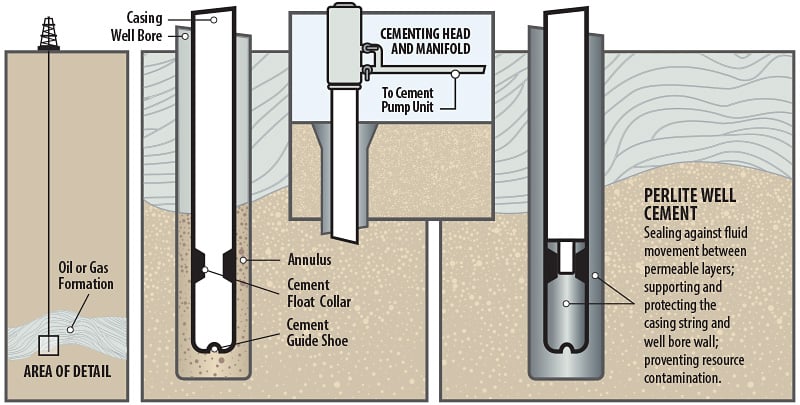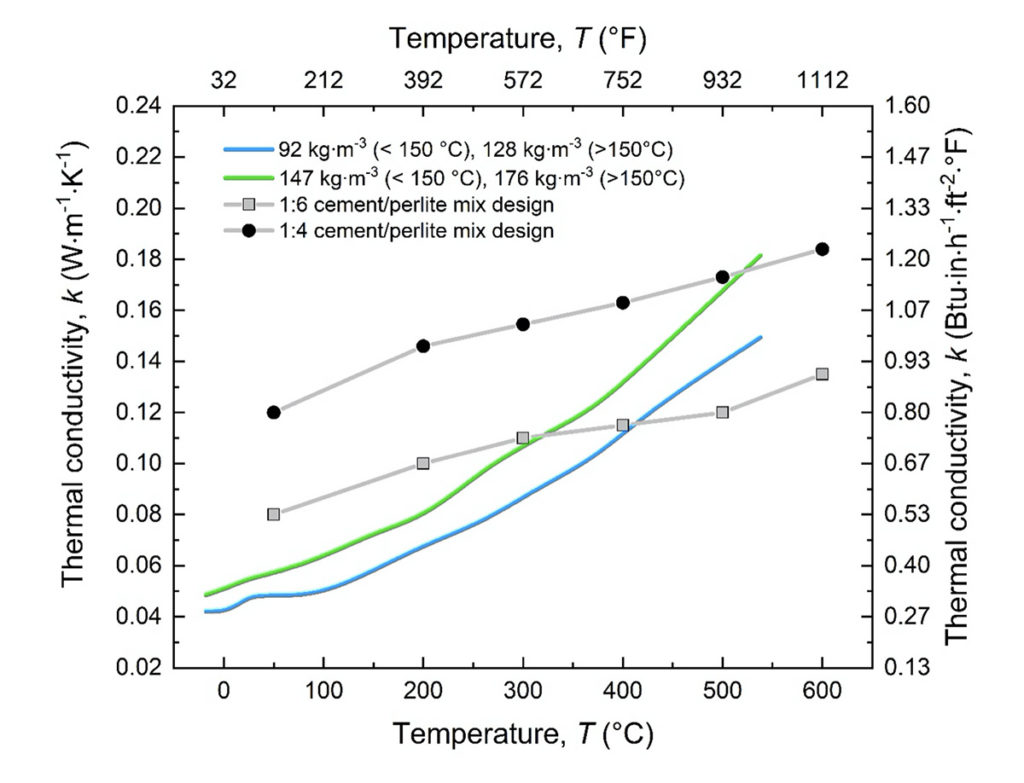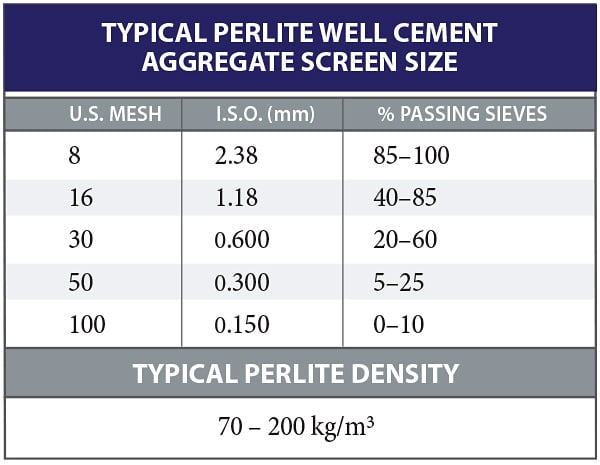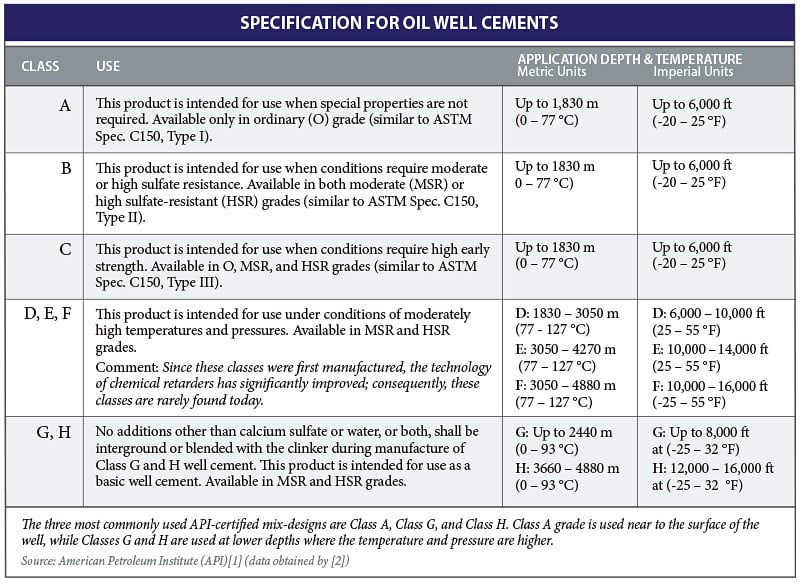How perlite improves performance in well cementing applications.
Well cementing is the process of introducing a cement mixture, consisting of Portland cement, additives, and water, to the annular space between the well bore and casing, or the space between two successive casing strings. This viscous slurry is forced out through the bottom of the drill casing and the space between the well bore and the casing. Well cements serve the following purposes:
1) seal fluid movement between permeable layers and prevent contamination of the well source,
2) support the casing string and well bore wall, and
3) protect the casing from corrosion.

Functions of Well Cementing Additives
Well cements are of particular interest where extreme temperature and/or pressure is concerned. For example, casings and well bores may be subjected to temperatures ranging from below freezing in permafrost zones, to as high as 300 °C (575 °F) in thermal recovery and geothermal wells. Temperature and pressure varies with well depth and type as well, reaching as high as 200 MPa (29,000 psi)*.
Due to the inherent extreme environment involved in well drilling, additives, such as perlite, are used alongside Portland cement to ensure effective performance under these conditions. Additives exist to enhance the properties of well slurries and promote successful placement between the casing and the geological formation. They also improve compressive strength and zonal isolation over the lifetime of the well.
*See Fig. 1 for thermal performance information.

Perlite Well Cements
Substituting perlite for other conventionally-used materials often has the effect of lowering the overall density of the well-cement mixture. The density of materials such as diatomaceous earth (DE), pozzolan, fly ash, and glass microspheres and beads typically ranges between 400 – 1,600 kg/m3 (25 – 100 lb/cu ft), whereas expanded perlite has a dry-density well below 250 kg/m3 (16 lb/cu ft). Substituting perlite puts less pressure on surrounding geologic layers, and lowers on-site demand on labor and equipment.
Perlite can also be introduced in higher concentrations as needed. Other materials, such as bentonite clay (or “gel” as it is known) must be incorporated along with a fair amount of water. Water adds to the density of the mix, plus, it is incompatible with high heat. With a melting point far exceeding the temperatures normally encountered in a well, and the ability to be incorporated without extra hydration, perlite is a natural choice for high heat situations where a lower density slurry is advantageous.
Finally, materials on-hand are used more effectively and costs are lowered when perlite is specified. Perlite Lightweight Cement can bridge voids and fill fractures in rock layers more easily than other mixtures, which minimizes loss to adjacent layers and costly remediation measures. Expanded perlite consists of up to 95% trapped air by volume, making it an excellent functional filler, and offset for more costly materials, or those that are becoming increasingly rare.

Advantages of Perlite Well Cements
- Ease of use and lower on-site mechanical requirements
- Increased thermal performance
- Compatible with high temperatures
- Increased impact strength and rheology
- Stops contraction under thermal conditions
- Higher yields with lower density
- Improved bridging; seals fractures more rapidly due to the lower plastic viscosity
- Excellent fluid loss characteristics; retains key characteristics of slurry for longer (e.g. viscosity, thickening time, density and compressive strength)
- Reduced pressure on surrounding geologic layers
- Available in a wide range of sizes and densities
Perlite is available in a wide variety of grades and sizes allowing for the adjustment of cement slurry properties. An appropriate selection is important to meet the needs of different API classes. Contact your local or regional perlite supplier for assistance with grade selection, and see the bibliography section[3]–[7] for more current and independent research pointing to the advantages of expanded perlite for well cements.


BIBLIOGRAPHY
[1] ISO 10426-1:2009, “Petroleum and natural gas industries—_Cements and materials for well cementing – Part 1: Specifications.”[2] E. Nelson and D. Guillot, Well Cementing, 2nd ed. Texas: _Schlumberger, 2006.
[3] E. Broni-Bediako, “Oil Well Cement Additives: A Review of the _Common Types,” Oil Gas Res., vol. 02, no. 02, pp. 1–7, 2016.
[4] O. V. Kazmina, N. A. Mitina, and K. M. Minaev, “Lightweight cement mortar with inorganic perlite microspheres for equipping oil and gas production wells,” Mag. Civ. Eng., vol. 93, no. 1, pp. 83–96, 2020.
[5] M. Kremieniewski, “Ultra-lightweight cement slurry to seal wellbore _of poor wellbore stability,” Energies, vol. 13, no. 12, 2020.
[6] J. O. Robertson, G. V. Chilingarian, and S. Kumar, “The Manufacture, Chemistry and Classification of Oilwell Cements and Additives,” Dev. Pet. Sci., vol. 19, pp. 61–100, 1989.
[7] A. Ahmed, B. Bageri, J. Al Jaberi, S. Elkatatny, and S. Patil, “Effect of Perlite Particles on the Properties of Oil-Well Class G Cement,” J. Pet. Sci. Eng., vol. 199, no. July 2020, pp. 1–17, 2020.
[8] Y. Xu and D. D. L. Chung, “Increasing the specific heat of cement paste _by admixture surface treatments,” Cem. Concr. Res., vol. 29, no. 7, pp. 1117–1121, 1999.
To download a .pdf of the Perlite for Use in Well Cements brochure, click here.
If you have technical questions on this topic, please email the technical contacts listed on our contact page.
Copyright © 2021 Perlite Institute All Rights Reserved
